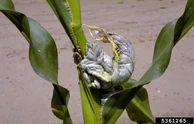| Sweet corn | |
|---|---|
 |
|
| Scientific Classification | |
| Kingdom: | Plantae |
| (Unranked): | Angiosperms |
| (Unranked): | Eudicots |
| (Unranked): | Commelinids |
| Order: | Poales |
| Family: | Poaceae |
| Genus: | Zea |
| Species: | Zea mays convar. saccharata var. rugosa |
| Plant Data | |
|---|---|
| Min germination temp: | 21°C (70°F) |
| Max germination temp: | 27°C (81°F) |
| Germination time: | 7 days |
| Time to transplanting: | +10 days |
| Time to harvesting: | +81 days |
| Mature height: | 2m (6½ft) |
| Mature spread: | 20cm (8in) |
| Ideal pH range: | 6.5 - 7.5 |
| Sow depth: | 3cm (1in) |
| Growing plant spacing: | 46cm (18in) |
| Growing row spacing: | 46cm (18in) |
| References: | [1][2] |
Sweetcorn (Zea mays convar. saccharata var. rugosa) is a type of maize which has been bred for its high sugar and low starch content. Once the cob has been picked the sugar in the kernels is slowly converted into starch, which is why home-grown sweet corn tastes so much sweeter than shop bought.[2]
Planner[]
| J | F | M | A | M | J | J | A | S | O | N | D | |||||||||||||
| Sowing time (indoors) | ||||||||||||||||||||||||
| Sowing time (outdoors - under glass) | ||||||||||||||||||||||||
| Sowing time (outdoors) | ||||||||||||||||||||||||
| Transplanting time | ||||||||||||||||||||||||
| Picking time | ||||||||||||||||||||||||
Growing[]
Location[]
Grow in full sun where shelter from strong winds is provided and is not water logged. Give it a home in a bed dug to at least a spade's depth to accommodate the deep roots.
Soil[]
It is not too particular about the soil type, but avoid clay. For best results incorporate plenty of organic matter and one handful of bonemeal per square meter (3ft) in March. Ideally the soil should be slightly acidic.[2]
Germination[]
Sweet corn can easily be germinated by placing a sheet of kitchen towel onto a plate, scattering the seeds ontop and then pouring warm water ontop until the kitchen towel is saturated, but there is no excess water. Then cover the plate with cling film and store in a warm area. Seeds are ready for transplanting once a green shoot can be clearly seen and a white root has grown.
Sowing[]
- Indoors
You should avoid disturbing the roots when transplanting, so it is best to use peat pots. You can germinate seeds as above, or plant directly into potting compost. Sow 2 seeds about 3cm (1in) deep, remove the weaker seedling once they emerge.
Transplanting[]
Harden off before planting outdoors. Leave 46cm (18in) between plants in all directions.
Sweet corn pollinates best when grown in a block so planting in 46x46cm (18x18in) squares in ideal.
Aftercare[]
If using cloches, remove them when foliage starts to touch the glass. Protect seedlings if birds are a problem. Keep down weeds, but do not hoe close to the plants to avoid damaging the shallow roots.[2]
Roots will appear at the base of the stem - cover them with soil or a mulch of old compost. The side shoots (tillers) which may develop should not be removed.[2]
Water in dry weather - this is especially important at flowering stage.[2]
Stake the plants if they grow tall and the site is exposed.[2]

Male flowers

A female flower with young silks
- Pollination
Tapping the tassels at the top of each stem when they are fully developed in late June or or July will help pollination.[2] To ensure pollination you may choose to transfer pollen to the female flowers where the leaves meet the stem.
Harvesting[]
Each plant will produce 1 or 2 cobs. Test for ripeness when the skins have turned chocolate brown. Pull back part of the sheath and squeeze a couple of grains between thumbnail and fingernail. If a watery liquid squirts out then the cob is unripe. If the liquid is creamy then the cob is just right for picking, but if the liquid is thick and doughy you have waited too long.[2]
Carefully twist off the ripe cob from the stem. Do this just before it is required for cooking.[2]
Troubles[]
- Full troubles list: Corn troubles
References[]
| Sweet corn varieties |
|
|---|---|
| Sweet corn | Minipop |




